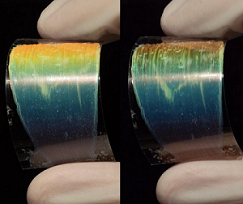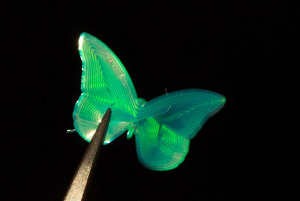
3D-Printed Ink Produces Elements with Disparate Optical Effects
EINDHOVEN, Netherlands, Sept. 2, 2021 — A light-reflective, 3D-printable liquid crystal ink could make it possible to use cholesteric liquid crystal — a human-made material found in TVs and smartphones that possesses properties between liquids and solid crystals — to add tunable color and iridescence to a range of applications from wearable sensors to decorative lighting. The ink has more viscosity than previous liquid crystal inks, which makes it more suitable for rapid 3D-printing techniques.
A research group from Eindhoven University of Technology (TU/e) collaborated with scientists from the Netherlands Organization for Applied Scientific Research (TNO), the Dutch Multinational Corp. (DSM), Brightlands Materials Center, and SABIC to create a liquid crystal, elastomer-based ink that self-assembles into a chiral photonic structure. The ink can be 3D-printed on a surface via direct ink writing (DIW).
“DIW is an extrusion-based 3D printing approach where an ink is dispensed from a small nozzle onto a surface on a layer-by-layer basis,” TU/e researcher Jeroen Sol said. “Current cholesteric liquid crystal inks cannot be printed with DIW, so we created a liquid crystal ink compatible with DIW.”
The light-reflective properties in the ink rely on the precise helical alignment of molecules throughout the material, which the researchers achieved by fine-tuning the printing process.
“To successfully print the new ink with DIW, we varied parameters like print speed and temperature,” Sol said.
The researchers controlled the molecular alignment of the material at the nanoscale with a high degree of accuracy, and gained greater control over the appearance and light-reflecting properties of the material by varying print speed. Tuning the speed and writing direction led to the formation of a slanted photonic axis, which had iridescence and polarization selectivity, and that resulted in a programmable, chiroptical photonic polymer material.

The crosslinked photonic film bar is coated and polymerized on a flexible plastic substrate displaying axially asymmetric color reflection and variable circular polarization selectivity based on angle of incidence. Courtesy of Jeroen Sol, Lanti Yang, Nadia Grossiord, Albert Schenning, and Michael Debije.
To further ensure that the ink printed properly, the team used low-molecular-weight liquid crystals for their ink. The molecules in the ink self-assembled into structures that displayed colors similar to the iridescent hues found in nature.
“Traditionally, this level of control is only possible with very specialized fabrication devices, so to do this with the new ink and DIW 3D printing is a real breakthrough,” Sol said.
In an example of materials science imitating nature, the researchers printed synthetic butterfly wings that mimicked the natural iridescent color found in some butterflies and that seemed to change when viewed from different angles. After creating films on the order of 10 cm2 with bar coating, they used DIW to generate intricate, spatially defined optical patterns. They adjusted the chiroptical properties of the ink by altering deposition rates. The optical properties of the final print could be varied spatially, resulting in spectacular visual effects generated from a single ink, during a single print.
Although the properties of cholesteric liquid crystal could be useful in many applications, the material in its traditional form is not viscous enough to make stable, solid structures, and it has been difficult to align its molecules to produce specific colors.

After removal from the substrate, the crosslinked elastomer (butterfly structure) is photographed as a free-standing photonic rubber. Courtesy of Jeroen Sol, Lanti Yang, Nadia Grossiord, Albert Schenning, and Michael Debije.
The ink combines straightforward processing with the freedom to select the iridescence and circular polarization of reflected light on a voxel-by-voxel basis. It could be used to make wearable biosensors that interact visually with the wearer, and its perspective-dependent appearance could make it suitable for specialized anticounterfeit markers or decorative iridescent coatings.
“What’s more, the combination of our new ink and DIW can be used to print the specialized optical structures needed for augmented reality headsets where real-life and artificial images are seamlessly combined,” Sol said. “The new materials could find their way into the HoloLenses of the future — now that would be something extraordinary.”
The research was published in Advanced Materials (www.doi.org/10.1002/adma.202103309).
Published: September 2021